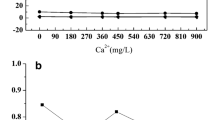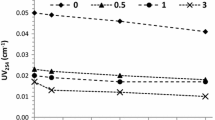Abstract
This study aims to investigate the influence of the coexistence of halogen ions (bromide/iodide) and biological source matters on the speciation and yield of trihalomethanes (THMs), haloacetic acids (HAAs), and N-nitrosodimethylamine (NDMA) during the ozonation and subsequent chlorination of water. The results show that the concentrations of brominated THMs and iodinated THMs increased with increasing bromide and iodide concentration. These results may be attributed to the higher reactivity of hypobromous acid and hypoiodous acid generated from the ozonation and subsequent chlorination in the presence of bromide or iodide ions. The presence of bromide increased the species of brominated HAAs. There was a shift from chlorinated HAAs to brominated HAAs after increasing the concentration of bromide. The effect of iodide on HAA formation was more complex than bromide. For most samples, the concentration of total HAAs (T-HAAs) increased to the maximum and then decreased with increasing iodide concentration. The components of the organic precursors also significantly influenced the formation of brominated and iodinated disinfection by-products (Br-DBPs and I-DBPs). Humic acids produced more CHBr3 (596.60 μg/L) than other organic materials. Microcystis aeruginosa cells produced the most tribromoacetic acid (TBAA, 84.16 μg/L). Furthermore, the yield of NDMA decreased with increasing bromide concentration, indicating that the formation of NDMA was inhibited by the high concentration of bromide.









Similar content being viewed by others
References
Adamantia AK, Euripides GS (2002) The impact of bromide on the formation of neutral and acidic disinfection by-products (DBPs) in Mediterranean chlorinated drinking water. Water Res 36:2596–2606
APHA (1998) Standard methods for the examination of water and wastewater, 20th edn. APHA, Washington, DC
Arora H, LeChevallier MW, Dixon KL (1997) DBP occurrence survey. J Am Water Works Assoc 89:60–68
Chang EE, Lin YP, Chiang PC (2001) Effects of bromide on the formation of THMs and HAAs. Chemosphere 43:1029–1034
Chen ZL, Xu BB, Qi H et al (2007) Determination of trace nitrosodimethylamine in water by high performance liquid chromatogram. China Water Waste Water 23:84–87
Chen Z, Yang L, Zhao S (2010) N-Nitrosamine formation during chlorination/chloramination of bromide-containing water. Water Sci Technol 10:462–471
Choi J, Valentine RL (2002) Formation of N-nitrosodimethylamine (NDMA) from reaction of monochloramine: a new disinfection by-product. Water Res 36:817–824
Darryl BJ, Aysenur S, Hocheol S (2012) The impact of bromide/iodide concentration and ratio on iodinated trihalomethane formation and speciation. Water Res 46:11–20
Dotson A, Westerhoff P, Krasner SW (2009) Nitrogen enriched dissolved organic matter (DOM) isolates and their affinity to form emerging disinfection by-products. Water Science & Technology 60:135–143
Goto Y, Matsuda T, Ito K et al (1999) Mutagenicities of N-nitrosodimethylamine and N-nitrosodiethylamine in Drosophila and their relationship to the levels of O-alkyl adducts in DNA. Mutat Res 425:125–134
Hong Y, Liu SB, Song HB (2008) Effects of quenching methods on HAA determination in chloraminated waters. J Am Water Works Assoc 100:89–99
Hrudey SE (2009) Chlorination disinfection by-products, public health risk tradeoffs and me. Water Res 43:2057–2092
Hua GH, Reckhow DA (2008) DBP formation during chlorination and chloramination: effect of reaction time, pH, dosage, and temperature. J Am Water Works Assoc 100:82–90
Hua GH, Reckhow DA, Kim J (2006) Effect of bromide and iodide ions on the formation and speciation of disinfection byproducts during chlorination. Environ Sci Technol 40:3050–3056
Julien LR, Gallard H, Croue JP (2012) Formation of NDMA and halogenated DBPs by chloramination of tertiary amines: the influence of bromide ion. Environ Sci Technol 46:1581–1589
Kampioti AA, Stephanou EG (2002) The impact of bromide on the formation of neutral and acidic disinfection by-products (DBPs) in Mediterranean chlorinated drinking water. Water Res 36:2596–2606
Kristiana I, Gallard H, Joll C et al (2009) The formation of halogen-specific TOX from chlorination and chloramination of natural organic matter isolates. Water Res 43:4177–4188
Lee W, Westerhoff P, Philippe J (2007) Dissolved organic nitrogen as a precursor for chloroform, dichloroacetonitrile, N-nitrosodimethylamine, and trichloronitromethane. Environ Sci Technol 41:5485–5490
Liang L, Singer PC (2003) Factor influence the formation and relative distribution of haloacetic acids and trihalomethanes in drinking water. Environ Sci Technol 37:2920–2928
Liu JL, Li XY (2010) Biodegradation and biotransformation of wastewater organic as precursors of disinfection byproducts in water. Chemosphere 81:1075–1083
Liu B, Gu L, Yu X (2012) Dissolved organic nitrogen (DON) in a full-scale drinking water treatment plant. J Water Suppl 61:41–49
Mitch WA, Sedlak DL (2002) Formation of N-nitrosodimethylamine (NDMA) from dimethylamine during chlorination. Environ Sci Technol 36:588–595
Nokes CJ, Fenton E, Randall CJ (1999) Modelling the formation of brominated trihalomethanes in chlorinated drinking waters. Water Res 33:3557–3568
Plummer JD, Edzwald JK (2001) Effect of ozone on algae as precursors for trihalomethane and haloacetic acid production. Environ Sci Technol 35:3661–3668
Richardson SD, Plewa MJ, Wagner ED et al (2007) Occurrence, genotoxicity, and carcinogenicity of regulated and emerging disinfection by-products in drinking water: a review and roadmap for research. Mutat Res 636:178–242
Shah AD, Mitch WA (2012) Halonitroalkanes, halonitriles, haloamides, and N-nitrosamines: a critical review of nitrogenous disinfection byproduct formation pathways. Environ Sci Technol 46:119–131
Shukairy HM, Miltner RJ, Summers RS (1994) Bromides effect on DBP formation, speciation, and control. 1. Ozonation. J Am Water Works Assoc 87:72–87
US Environmental Protection Agency (2003) Determination of haloacetic acids and dalapon in drinking water by liquid-liquid microextraction, derivatization, and gas chromatography with electron capture detection. US Environmental Protection Agency, Washington, DC
von Gunten U (2003) Ozonation of drinking water: part II. Disinfection and by-product formation in presence of bromide, iodide or chlorine. Water Res 37:1469–1487
Wei YY, Liu Y, Zhang Y et al (2011) Influence of soluble microbial products (SMP) on wastewater disinfection byproducts: trihalomethanes and haloacetic acid species from the chlorination of SMP. Environ Sci Pollut Res 18:46–50
Yang X, Guo WH, Shen QQ (2011) Formation of disinfection byproducts from chlor(am)ination of algal organic matter. J Hazard Mater 197:378–388
Zhang JZ, Yu JW, An W et al (2011) Characterization of disinfection byproduct formation potential in 13 source waters in China. J Environ Sci China 23:183–188
Acknowledgments
This study was supported by the National Science Foundation of China (nos. 51078091 and 51008083) and Supporting Program of the “Twelfth Five-year Plan” for Sci & Tech Research of China (no. 2013BAC01B01).
Author information
Authors and Affiliations
Corresponding author
Additional information
Responsible editor: Hongwen Sun
Rights and permissions
About this article
Cite this article
Zha, Xs., Liu, Y., Liu, X. et al. Effects of bromide and iodide ions on the formation of disinfection by-products during ozonation and subsequent chlorination of water containing biological source matters. Environ Sci Pollut Res 21, 2714–2723 (2014). https://doi.org/10.1007/s11356-013-2176-x
Received:
Accepted:
Published:
Issue Date:
DOI: https://doi.org/10.1007/s11356-013-2176-x




